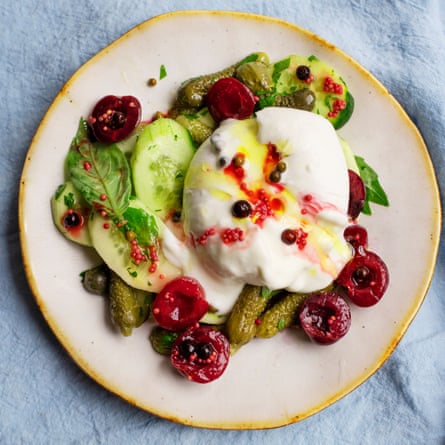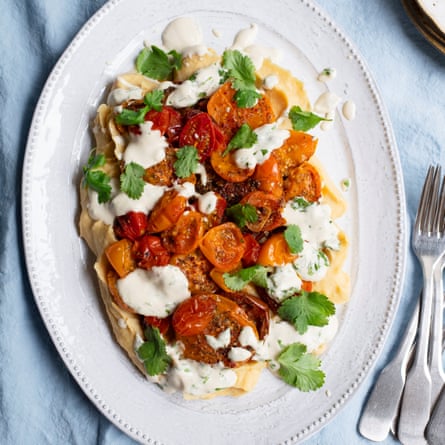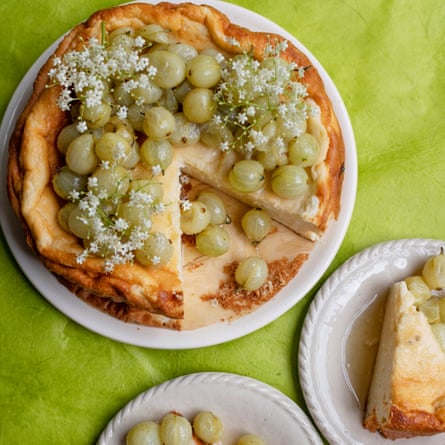
Lunch in the sun. A long, leisurely meal with friends and family or a more intimate affair for just two. Either is a fine way to celebrate a glorious summer afternoon. For a feast I tend to choose dishes that are not especially time sensitive. This time, a platter of roast tomatoes with za’atar and dark red aleppo pepper, the fruits atop a soft mound of creamed chickpeas and a tahini-scented dressing.
There will be something to start, just a light, seasonal plate of melting white cheese, perhaps – mozzarella or burrata – cheered up with pickles (I used cherries this time) and tiny sweet-sour gherkins. The cherries can be kept in a jar to accompany cheese – they have a delightful affinity with a milky caerphilly – or maybe dot them through a salad with cucumber and lamb’s lettuce. Their juice is a useful addition to any salad dressing.
For a more intimate summer lunch, I shall stand at the kitchen table and chop lemongrass and garlic, spring onions and soft, green spring cabbage, then toss them with fat, wild prawns in a very hot pan. A splash of soy and fish sauce, this is the sort of special dish that always seems better when cooked just for two. The prawns, fat and sweet, are a rare treat.
Dessert will be a yoghurt cake, soft like a sponge but with a nod to cheesecake. There will be berries too, cooked with honey to spoon on top. The gooseberries are finally here and to be celebrated with any form of dairy (fool first, crumble and cream next, then as a compote with yoghurt).
If there are only a couple of us I will still make cake – it makes a pleasing weekend breakfast bake.
Spring cabbage, prawns and lime (pictured above)
Sometimes, summer lunch is a small event but nonetheless special. If this is an intimate lunch I am happy to make something for just two of us to share – a stir-fry, perhaps, (something I will never consider for a large group) that can be cooked while you chat, the kitchen doors wide open to the sunshine.
Serves 2
spring cabbage 200g
ginger 60g
garlic 2 cloves
lemongrass 2 large stalks
chillies 2 small, hot
spring onions 2
groundnut or vegetable oil 3 tbsp
prawns 400g large, raw
lime juice of 1 large
nam pla (Thai fish sauce) 2 tbsp
sugar (palm sugar or caster) 1 tsp
soy sauce 1 tbsp
coriander leaves a large handful
Thai basil leaves a handful
Start the prep. It is best to have everything to hand, as when you start cooking, it all happens quite quickly. Wash the leaves of the cabbage, then shred them into pieces about the width of pappardelle.
Peel the ginger and grate it finely. Peel and finely chop the garlic. Remove the outer leaves of the lemongrass, then very finely slice the inner leaves. Finely chop the chillies, removing the seeds if you wish. (They will add a little extra heat if left in.) Shred the spring onions finely.
Warm the oil in a wok or wide, shallow pan. Add the ginger, garlic, lemongrass, chillies and spring onions and stir-fry for a couple of minutes until the garlic starts to colour. Take care not to let it burn. Keeping the heat high, introduce the prawns. As they turn opaque and colour slightly add the lime juice, nam pla and sugar. When all is sizzling, add the shredded cabbage, turning the leaves over as they start to darken and wilt.
As soon as all is sizzling and tender, toss in the soy sauce, coriander and Thai basil leaves.
Mozzarella, cucumber, gherkin, cherries
I rarely offer a starter, preferring to put a few bits and pieces on the table for everyone to help themselves. One of those bits and pieces will be a salad of some sort, perhaps mozzarella or burrata thoughtfully seasoned, the sort of dish that can appear as both starter or snack. A prelude to a summer lunch needs to be refreshing, such as this mozzarella with a crisp dressing of pickled cherries, cucumber, gherkins and preserved green peppercorns. Make the cherries a good day or two before – they will keep for several weeks in a jar in the fridge.
Serves 2
For the pickled cherries
red wine vinegar 150ml
soft brown sugar 75g
yellow mustard seeds 1 tsp
juniper berries 10
sea salt ½ tsp
cherries 250g, halved and stoned
For the salad
cucumber 250g
gherkins or cornichons 90g
bottled green peppercorns 1 tsp
basil 12 leaves
parsley 2 tbsp, chopped
olive oil 3 tbsp
mozzarella or burrata 2 balls
pickled cherries 4 tbsp
To pickle the cherries, put the red wine vinegar and soft brown sugar in a medium-sized stainless-steel or enamelled pan and bring to the boil. Add the mustard seeds, juniper berries and sea salt. When the sugar has dissolved, add the cherry halves to the hot vinegar and sugar. Transfer the fruit and liquor to a sterilised jar and seal.
To make the salad, peel the cucumber, cut in half lengthways and remove the wet, seedy core. Slice the flesh into pencil-thin pieces and put them in a bowl. Cut the gherkins or cornichons in half lengthwise then add them to the cucumber. Scatter over the bottled green peppercorns.
Shred the basil leaves and stir, together with the chopped parsley, into the salad. Pour in the olive oil and 2 tablespoons of the pickling liquor from the cherries then stir in 4 tablespoons of the cherries.
Put a ball of mozzarella or burrata on each plate or shallow dish, spoon the cucumber salad and cherries around the cheese and serve.
Tomatoes, chickpeas and tahini

I sometimes put a large roasting tin of tomatoes in to bake, with olive oil, sometimes garlic and sometimes not, and either thyme sprigs or a dusting of dried chillies. While they bake, and their juices run into one another, I decide what to do with them. Even left to cool, they are a useful thing to have in the fridge. For a midsummer lunch, I served them with a fluffy puree of warm chickpeas and a dressing of tahini and yoghurt. It was a generous dish, warm, fruity and satisfying, and one that can be multiplied easily to suit larger events.
Serves 4
tomatoes 750g, assorted
garlic 2 cloves
olive oil 3 tbsp
aleppo pepper a pinch
za’atar 1 tbsp
chickpeas 2 x 400g tins
coriander leaves 10g
For the dressing
tahini 2 lightly heaped tbsp
olive oil 2 tbsp
thick yoghurt 6 tbsp
lemon juice of ½
Preheat the oven to 180C fan/gas mark 6. Cut the tomatoes in half and put them in a roasting tin. Peel the garlic, slice thinly and scatter among the tomatoes, then trickle over the olive oil and season with salt and a good pinch or two of the aleppo pepper and the za’atar. Bake for about 45 minutes, until the tomatoes are soft, juicy and their skin is browned in places.
While the tomatoes bake, drain the chickpeas, tip them into a medium-sized saucepan and cover them with water. Bring the water to the boil, then remove from the heat and set aside, without draining, until the tomatoes are ready.
To make the dressing, put the tahini in a small mixing bowl and beat in the olive oil with a small whisk or fork. Add the yoghurt and season with the lemon juice – salt tasting as you go – and some ground black pepper. Stir in as much of the chickpea water as you need to turn it to a creamy dressing – about 3-4 tablespoons – then set aside.
When the tomatoes are ready, remove from the oven. Drain the chickpeas, keeping back 3 tablespoons of their cooking water. Tip them, and the water, into a food processor and add a generous seasoning of salt and black pepper, then whizz to a puree. (You can alter the consistency of the puree by adding a little olive oil.)
Spoon the chickpea puree on to a warm serving dish. Put the tomatoes and their juices among the puree, then trickle the tahini dressing over them. A few coriander leaves, if you like them, are an appropriate last-minute addition.
Gooseberry yoghurt cake

Somewhere between sponge and cheesecake, this yoghurt-based cake is light and perfect for a summer’s afternoon. Leave it to cool in its tin – it will sink as it cools – then refrigerate it for a couple of hours before eating. A fruit compote is good on the side – especially apricots, gooseberries or blackcurrants.
Serves 6-8
eggs 4
golden caster sugar 100g
lemon grated zest of 1
natural yoghurt 500g
plain flour 40g
cornflour 3 tbsp
gooseberries 450g
honey 3 tbsp
Line a high-sided 20cm cake tin with baking parchment and set the oven at 140C/gas mark 3.
Separate the eggs, putting the yolks into the bowl of a food mixer. Add the sugar to the yolks and whisk until thick and creamy.
Add the lemon zest to the yolk mixture. Stop the machine, remove the bowl then stir in the yoghurt, using a large metal spoon. Sieve together the flour and cornflour then mix this into the batter.
Whisk the egg whites until thick and fluffy then fold them into the mixture. Be thorough but gentle, making sure there are no pockets of egg white. Transfer the mixture to the cake tin and bake in the hot oven for 50 minutes until lightly risen. The cake will appear soft and risen, like a souffle, and will settle once out of the oven.
Let the cake cool completely before removing from the tin.
For the gooseberry compote, top and tail the gooseberries, then put them into a stainless-steel saucepan with the honey. Bring to the boil, then lower the heat and continue cooking for 10 minutes or until the berries are soft and swollen.
Serve the cake in thick wedges with the gooseberry and honey spooned over the top.



